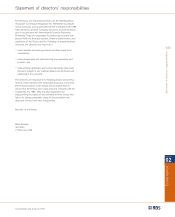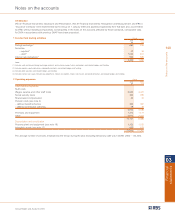RBS 2005 Annual Report Download - page 143
Download and view the complete annual report
Please find page 143 of the 2005 RBS annual report below. You can navigate through the pages in the report by either clicking on the pages listed below, or by using the keyword search tool below to find specific information within the annual report.
section
03
Financial
statements
141
Accounting policies
Annual Report and Accounts 2005
Financial liabilities may be designated as at fair value through
profit or loss only if such designation (a) eliminates or
significantly reduces a measurement or recognition
inconsistency; or (b) applies to a group of financial assets,
financial liabilities or both that the Group manages and
evaluates on a fair value basis; or (c) relates to an instrument
that contains an embedded derivative which is not evidently
closely related to the host contract.
The principal categories of financial liabilities designated as at
fair value through profit or loss are (a) structured liabilities
issued by the Group: designation significantly reduces the
measurement inconsistency between these liabilities and the
related derivatives carried at fair value, and (b) investment
contracts issued by the Group's life assurance businesses: fair
value designation significantly reduces the measurement
inconsistency that would arise if these liabilities were
measured at amortised cost.
All other financial liabilities are measured at amortised cost
using the effective interest method (see note 4 above).
Fair value for a net open position in a financial liability that is
quoted in an active market is the current offer price times the
number of units of the instrument held or issued. Fair values
for financial liabilities not quoted in an active market are
determined using appropriate valuation techniques including
discounting future cash flows, option pricing models and other
methods that are consistent with accepted economic
methodologies for pricing financial liabilities.
16. Derecognition
A financial asset is derecognised when it has been transferred
and the transfer qualifies for derecognition. A transfer requires
that the Group either: (a) transfers the contractual rights to
receive the asset’s cash flows; or (b) retains the right to the
asset’s cash flows but assumes a contractual obligation to pay
those cash flows to a third party. After a transfer, the Group
assesses the extent to which it has retained the risks and
rewards of ownership of the transferred asset. If substantially
all the risks and rewards have been retained, the asset remains
on the balance sheet. If substantially all of the risks and
rewards have been transferred, the asset is derecognised. If
substantially all the risks and rewards have been neither
retained nor transferred, the Group assesses whether or not it
has retained control of the asset. If it has not retained control,
the asset is derecognised. Where the Group has retained
control of the asset, it continues to recognise the asset to the
extent of its continuing involvement.
A financial liability is removed from the balance sheet when the
obligation is discharged, or cancelled, or expires.
17. Capital instruments
The Group classifies a financial instrument that it issues as a
financial asset, financial liability or an equity instrument in
accordance with the substance of the contractual arrangement.
An instrument is classified as a liability if it is a contractual
obligation to deliver cash or another financial asset, or to
exchange financial assets or financial liabilities on potentially
unfavourable terms. An instrument is classified as equity if it
evidences a residual interest in the assets of the Group after
the deduction of liabilities. The components of a compound
financial instrument issued by the Group are classified and
accounted for separately as financial assets, financial liabilities
or equity as appropriate.
18. Derivatives and hedging
Derivative financial instruments are recognised initially, and
subsequently measured, at fair value. Derivative fair values are
determined from quoted prices in active markets where
available. Where there is no active market for an instrument,
fair value is derived from prices for the derivative’s components
using appropriate pricing or valuation models.
A derivative embedded in a contract is accounted for as stand-
alone derivative if its economic characteristics are not closely
related to the economic characteristics of the host contract; unless
the entire contract is carried at fair value through profit or loss.
Gains and losses arising from changes in fair value of a
derivative are recognised as they arise in profit or loss unless
the derivative is the hedging instrument in a qualifying hedge.
The Group enters into three types of hedge relationship:
hedges of changes in the fair value of a recognised asset or
liability or firm commitment (fair value hedges); hedges of the
variability in cash flows from a recognised asset or liability or a
forecast transaction (cash flow hedges); and hedges of the net
investment in a foreign entity.
Hedge relationships are formally documented at inception. The
documentation includes identification of the hedged item and
the hedging instrument, details the risk that is being hedged and
the way in which effectiveness will be assessed at inception and
during the period of the hedge. If the hedge is not highly
effective in offsetting changes in fair values or cash flows
attributable to the hedged risk, consistent with the documented
risk management strategy, hedge accounting is discontinued.
Fair value hedge – in a fair value hedge, the gain or loss on the
hedging instrument is recognised in profit or loss. The gain or
loss on the hedged item attributable to the hedged risk is
recognised in profit or loss and adjusts the carrying amount of
the hedged item. Hedge accounting is discontinued if the
hedge no longer meets the criteria for hedge accounting or if
the hedging instrument expires or is sold, terminated or
exercised or if hedge designation is revoked. If the hedged item
is one for which the effective interest rate method is used, any
cumulative adjustment is amortised to profit or loss over the life
of the hedged item using a recalculated effective interest rate.
Cash flow hedge – where a derivative financial instrument is
designated as a hedge of the variability in cash flows of a
recognised asset or liability or a highly probable forecast
transaction, the effective portion of the gain or loss on the
hedging instrument is recognised directly in equity. The
ineffective portion is recognised in profit or loss. When the
forecast transaction results in the recognition of a financial asset
or financial liability, the cumulative gain or loss is reclassified
from equity in the same periods in which the asset or liability
affects profit or loss. Otherwise the cumulative gain or loss is
removed from equity and recognised in profit or loss at the same
























